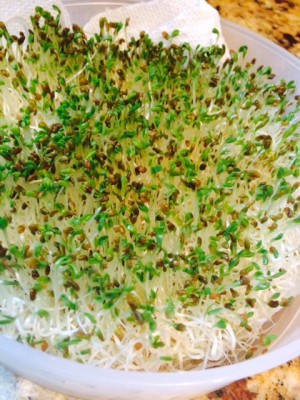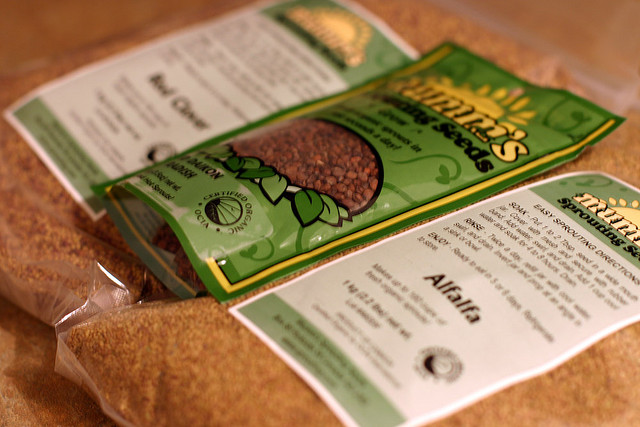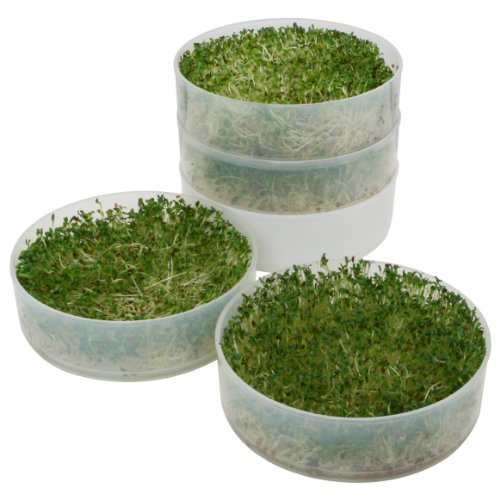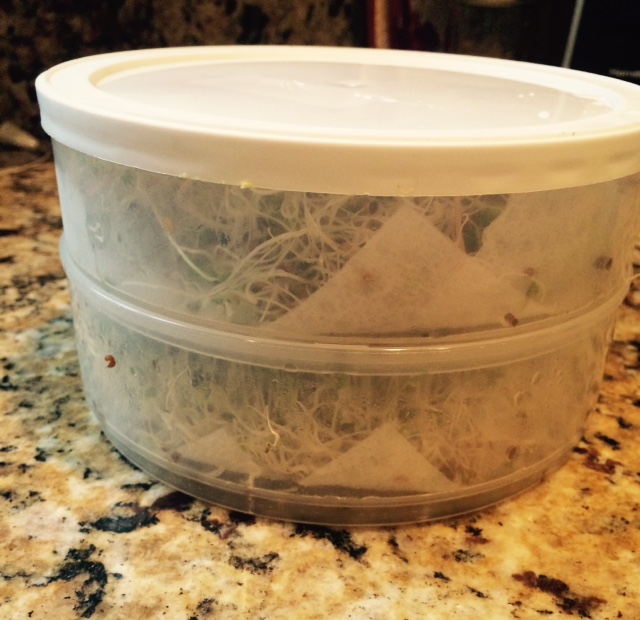I recently created a survey to help me gauge how people are accessing food and meals. Are they cooking at home, or eating out more often? To my surprise more people are eating meals at home and would rather eat meals at home. At the same time 35% of those same people wanted to eat healthier, but struggled with having time to cook healthy meals. I would like to open your eyes to a brand new way to eat healthier. It takes less than two minutes a day, it’s cheap, super easy, convenient, delicious, sustainable, do it yourself, and even fun – sprouting.
What are Sprouts?

Most of you may know what sprouts are. You know, the cute little green munchy things that you get on a gourmet sandwich. Or you may see them at your local grocery store packaged cutely in a little plastic container. When I first got started sprouting I thought it was the oddest thing ever. I received a bunch of different sprouting seeds and a plastic sprouting kit from a lovely woman; who taught me the ropes. But honestly my first thoughts were – what the heck do I do with all of this? I won’t have time for this! I was under the impression that sprouts could only be grown in some high tech commercial greenhouse under perfect conditions. Or I’d have to tend to them like a garden. But to my surprise sprouting was one of the easiest and most rewarding things I’ve ever done.
Sprouting vs Gardening
You may think sprouting could involve the same time commitments as gardening does. In actuality sprouting is by far much easier and quicker than gardening! This is why I absolutely love it, and you should too. There is barely any maintenance like a garden – no weeding, no fertilizing, no planting in a pot or the ground, no messy soil, no waiting weeks or months before harvesting, none of that! All you need is sprouting seeds, water, a sprouting vessel, 4-10 days (depending on the sprout), and two minutes twice a day to water your little sprout babies. THAT’S IT! And no matter where you live, the climate, or the season you can sprout in your own home all year round! I bet you’re wondering why you haven’t taken up sprouting sooner!
Nutrition in Sprouts
How much nutrients can really be in a little handful of tiny sprouts? Surprisingly these tiny little guys pack a big nutritional punch that one may not expect. Many sprouts are high in protein which may be a shocker. Its a frequent misconception of people to think you only get protein from meat. But many vegetable sources including sprouts can offer upwards of a fourth of your daily recommended intake of protein; in just half a cup of sprouts! It’s easier to digest protein, much more sustainable, more convenient, and cheaper! How can you go wrong?
Sprouts also contain high amounts of fiber. Everyone is always telling you, eat more fiber, and for good reason. Fiber helps to lower blood cholesterol and glucose and helps immensely with digestion and staying regular. Fiber is very important when trying to lose weight as well as maintaining a healthy weight.
Sprouts also contain a cocktail of many vitamins and minerals depending on the type of sprout. Vitamin A, C, B, and E are often found in most sprouts. And iron, magnesium, calcium, potassium, and zinc are also common minerals in sprouts. Whats unique is the nutrition density compared to weight. With sprouts your getting a ton of nutrition packed into a very small weight of material.
How to get Started!

You will need:
- Sprouting Seeds; I recommend starting with broccoli, alfalfa, and salad mix sprouts. There are many starter packs on the market that include easily sprouted seeds like the ones I’ve listed above. Alfalfa is my all time favorite! Look for organic sprouts from a reputable brand. I have included a few sites that are very well known: Sprout People, mumm’s, and Sproutman.
- Sprouting Vessel; I use a 4 tray plastic sprouter which I love. It’s super easy and convenient to use, and one of the cheaper options, $15 dollars for this one on Amazon. There are many other options out there, but I would recommend trying this one first.

- Water and a bowl; THAT’S IT!
Now comes the fun part!
Soaking- Place about a tablespoon of seeds in a bowl of room temperature water. Depending on the type of seed, it will have to soak for usually 6 hours, but overnight would be just fine. This is the worst part for me, just because I’m so impatient!
Draining- Once your seeds have soaked, place them in one of the trays, and let the water drain out. You can save the water if you choose; it contains enzymes from soaking the seeds and can be drank for additional health benefits.
Placement- Make sure the seeds are evenly spread in the vessel, making sure they are not too overcrowded. Place the seeds in a warm place, out of direct sunlight. Sprouts don’t really need sunlight, because plants don’t start to photosynthesize until they develop leaves. So the sprouts will only need small amounts of sunlight.
Rinsing- This is the only care your seeds will need for the next several days. You must rinse and drain your seeds twice a day with room temperature water. If its winter and the house is cold, your water could be a bit warmer to warm up the cold seeds, and opposite if the house is hot use cooler water to cool down your seeds. Treat your baby sprouts the way you would want to be treated 🙂
Waiting- In a few days your seeds will start to break a small sprout out of its shell, and after several days small greenish sprouts will develop. This is a very magical moment for first time sprouters!
Knowing when their done- The first time I sprouted I didn’t know how to tell when the little guys were done doing their thing. My advice to you is, you will just know, its as simple as that. When the sprouts are about one inch in length, the tray looks full, green, and like a nice head of sprout hair is when they are done!
Storing- Most sprouts will store for a week and a half to two weeks. I like to put a paper towel underneath my bed of sprouts to keep the sprouts extra dry and less moisture which breeds mold and bacteria. Store them covered in the refrigerator. The cool thing about the trays, are you can stack them if you sprouted a few different sprouts and fit them easily in the fridge all in one piece!
Enjoy- Enjoy your sprouts straight up as a snack, in salad, on a sandwich, in place of lettuce, on top of cooked meals, in wraps, over caprese salads, or any other way you can think of! They are absolutely delicious and super nutritious. Start sprouting today!

Great article, you have inspired this women to start sprouting again!!! Love reading your posts.
Thanks for the article! I’m going to start sprouting in my apartment:)